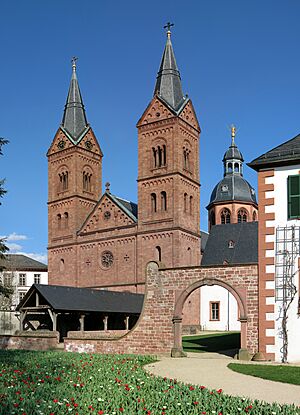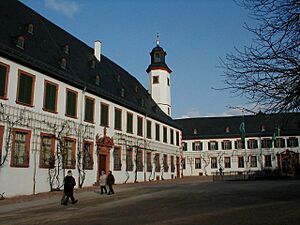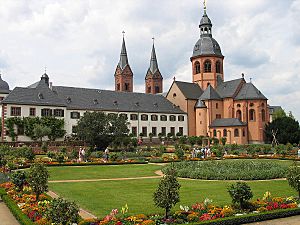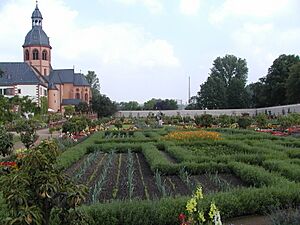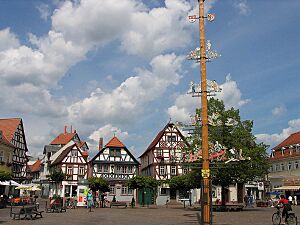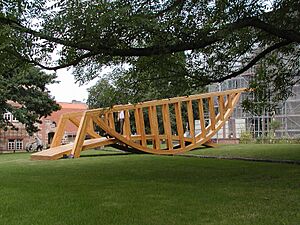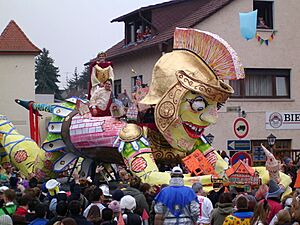Seligenstadt facts for kids
Quick facts for kids
Seligenstadt
|
||
|---|---|---|
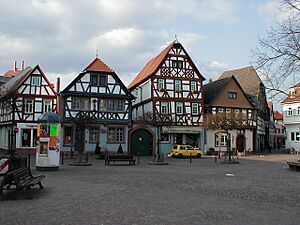
Marketplace
|
||
|
||
| Country | Germany | |
| State | Hesse | |
| Admin. region | Darmstadt | |
| District | Offenbach | |
| Elevation | 109-118 m (−278.1 ft) | |
| Population
(2022-12-31)
|
||
| • Total | 21,568 | |
| Time zone | CET/CEST (UTC+1/+2) | |
| Postal codes |
63500
|
|
| Dialling codes | 06182 | |
| Vehicle registration | OF | |
| Website | www.seligenstadt.de | |
Seligenstadt is a town in Germany, located in the state of Hesse. It is one of Germany's oldest towns. It was very important way back in the time of Charlemagne, a famous emperor.
Contents
Geography
Where Seligenstadt is Located
Seligenstadt is one of 13 towns in its area, the Offenbach district. It sits on the left side of the Main River. The town is about 25 kilometers (15 miles) southeast of Frankfurt am Main. It is also right next to the state of Bavaria.
Nearby Towns and Villages
Seligenstadt shares borders with several other places. To the north is Hainburg. To the east is Karlstein, which is in Bavaria. To the southeast is Mainhausen. To the south is Babenhausen. And to the west is the town of Rodgau.
Parts of Seligenstadt
Seligenstadt is made up of three main parts, called Stadtteile. These are Seligenstadt itself, Klein-Welzheim, and Froschhausen.
History
Ancient Times: The Romans Arrive
Around the year 100 AD, during the time of the Roman Emperor Trajan, a Roman army camp was built here. This camp was called Selgum. About 500 Roman soldiers lived there. They were part of the 22nd Roman Legion. Their job was to keep the area safe along the Limes Germanicus, which was a border wall.
Around 260 AD, the Roman border fell apart because of attacks from the Alamanni people. The Roman soldiers left their camp. Later, a new settlement grew up on the old camp's ruins. It was called Mulinheim superior, or Obermühlheim.
The Middle Ages: A New Name and a Monastery
Seligenstadt was first written about on January 11, 815. It was still called Obermühlheim then. The town was founded by Einhard, who was a writer for Charlemagne. Einhard received the settlement from Louis the Pious in 815. He then started a Benedictine monastery here.
Something special happened that changed the town's name. The bones of two Christian martyrs, Marcellinus and Peter, were brought here from Rome. They were moved from a church in the Odenwald to Obermühlheim. Because of these "blessed ones," the town's name soon changed to Seligenstadt. This means "town of the blessed ones" in German.
Around 830, work began on the Einhard-Basilika. This church is now a famous landmark in Seligenstadt. Einhard died in 840. He and his partner, Imma, are buried in a chapel inside the church.
In 1028, an important meeting of church leaders was held in Seligenstadt. One big decision was to start "ember days," which had strict rules for fasting. In 1063, Emperor Heinrich IV said that the Archbishop of Mainz rightfully owned the abbey.
In 1188, Emperor Friedrich Barbarossa visited Seligenstadt. During his rule, around 1175, the town gained its town rights. A royal palace, called a Kaiserpfalz, was built by the Main River. It's not clear if Barbarossa or a later emperor built it. Until 1309, Seligenstadt was a free imperial city. Then, it became part of the Archbishopric of Mainz. The Archbishop ruled the town until 1803.
Later Times: Changes and Wars
In 1527, the Archbishop of Mainz made new rules for the town. These rules greatly limited the rights of the people of Seligenstadt.
During the Thirty Years' War, which was a big war in Europe, Swedish soldiers took over the abbey. The Swedish king, Gustav II Adolf, spared the town from being destroyed. This was because the townspeople paid him money. However, the soldiers who stayed behind still robbed the town and the abbey. In 1685, the abbey buildings were rebuilt.
Modern History
In 1803, the Archbishopric of Mainz lost its power. Seligenstadt then became part of the Grand Duchy of Hesse-Darmstadt. The abbey was closed down. In 1832, Seligenstadt became part of the Offenbach district. In 1882, a railway line opened, connecting Seligenstadt to other towns.
Recent Times
In 1977, two nearby communities, Froschhausen and Klein-Welzheim, became part of Seligenstadt. This happened during a big change in how towns were organized in Hesse.
Main Sights
-
The Hans Memling House.
The Einhard-Basilika
The Basilika St. Marcellinus und Petrus is Seligenstadt's most famous building. It is also known as the Einhard-Basilika. It holds the bones of Saints Marcellinus and Peter. Most of the church you see today was rebuilt in the Baroque style. This happened for its 900th birthday.
However, the main part of the church, built by Einhard, is still there. The big tower in the middle is Baroque. The two towers at the front were added later, in 1868. Inside, you will see many Baroque features. These include the main altar and the fancy screen around the choir. The silver box holding the saints' bones is behind this screen. A Romanesque cross hangs above it.
Since 1925, the church has had a special title from the Pope: minor basilica. Even though the building has changed a lot, it is one of the largest churches with a basic Carolingian design north of the Alps.
The Seligenstadt Abbey
None of the first Benedictine abbey buildings from the 9th century are still standing. The oldest parts of the Kloster Seligenstadt that we can see today are from the 11th century. The most impressive parts are from the Baroque period. These include the library and the Prälatur with its "emperor's hall." The abbey was closed in 1803.
The abbey has been fully restored. This includes the beautiful Baroque garden. This garden was a mix of a herb and vegetable garden and a formal park. A museum has opened in the abbey. It shows the history of the town and the abbey.
The Royal Palace (Kaiserpfalz)
The Palatium, also known as the Kaiserpfalz, was built by the Main River. It dates back to the time of emperors Friedrich Barbarossa or Friedrich II (12th-13th century). Today, only the front wall facing the Main is left. It has double and triple arches made of red sandstone.
This rectangular palace was quite small. It measured about 47 meters by 14 meters. Perhaps the Emperor used it as a weekend home or a small hunting lodge. The first repairs happened in 1938. Work to restore the south and west walls has been ongoing since 1996.
Other Old Buildings
The Romanisches Haus is from around the same time. It is a strong stone building with large arches on the ground floor. On the second floor, there are double arches. In 1187, it was a local court. In 1188, Emperor Barbarossa held court here. It was restored in 1984. Today, cultural events take place there.
The town's defenses were built in the 12th century and made stronger in the 15th century. They originally had four gate towers and six defense towers. Only the Steinheimer Tor gate, built in 1603-1605, remains. Three of the defense towers are still standing. The front of the Kaiserpfalz was part of the town wall. Most of the town's defenses were torn down in the 1800s.
The town hall is in the marketplace. It was renovated in 1823. It is the only building in the Neoclassical style among many timber-frame houses. Two old stone carvings were put into the building from an earlier town hall. The square tower used to be part of the old church. That church was torn down when the town started using the Einhard-Basilika in 1812.
Timber-Frame Houses
Seligenstadt has many historic buildings. A lot of them are beautiful timber-frame houses from the 1600s and 1700s. Some of these are protected as historic landmarks. Because of this, Seligenstadt is part of the "German Timber Frame Road." This is a special route for tourists.
Most of these two- and three-story timber-frame houses are around the marketplace. You can also find them on nearby streets. Good examples are the Alte Schmiede (Old Smithy), which is now a restaurant. There's also the historic pharmacy with its special sign. The Einhard-Haus from 1596 has a beautifully decorated window.
There is a timber-frame area called Klaa-Frankreich. This means "Little France" in German. After the Thirty Years' War, many people had died. So, the abbot brought new people from a French-speaking area to live here. Names like Beike and Bonifer still show that these French-speaking settlers once lived here.
Buildings Outside the Town Center
- In Klein-Welzheim, near the old abbey fishponds, there is a moated palace. It looks like a medieval castle but has Baroque additions. The abbot of Seligenstadt built it in 1707 as a summer home.
- In Froschhausen, the old town hall is important. It was built in 1939. The church that used to be there was torn down, but its tower was kept and made part of the new town hall. Froschhausen also has other old timber-frame buildings.
Culture
The Town's Name: A Legend
There is a fun legend about how Seligenstadt got its name. It is not about the saints' bones. It is about Einhard and his daughter, Emma (or Imma). The story says Einhard ran away with Emma. They lived in Obermulinheim.
One night, Emperor Charlemagne was passing through the town. He went into an inn where his daughter was working. She served him pancakes, and he loved the taste. Charlemagne realized he had found his runaway daughter. He supposedly said, "Blessed be called the town, as I found my daughter Emma again." The German word for "blessed" is selig, and "town" is Stadt. So, the name Seligenstadt came from this. You can still see this "quote" on a special window at the Einhardhaus in Seligenstadt.
The Seligenstadt Escort
The Seligenstädter Geleit is a unique tradition in Germany. It comes from the early Middle Ages. In those times, groups of merchants traveled to the Frankfurt Trade Fair. The journey was dangerous because of highwaymen and robber knights.
So, in 1240, Emperor Friedrich II gave the merchants a special "safe-conduct" letter. This letter meant that local rulers had to provide armed guards for the merchants. The guards would change near Seligenstadt.
From this time came a custom called Hänselbrauch. New salesmen had to drink a whole liter of wine from a special "escort spoon" without stopping. If they could not do it, they had to buy food for the merchants' group. This custom, in a milder form, is still a highlight of the Geleitsfest (Escort Festival). This festival happens every four years.
Carnival (Fastnacht)
Seligenstadt is well known for its Carnival parade. This parade happens every year on Rosenmontag (Shrove Monday). It winds through the old town and nearby areas. Records show this parade has been happening since 1859.
Today, the parade has over a hundred amazing floats and groups. About forty thousand visitors come to watch it. During Carnival, the people of Seligenstadt call themselves "Schlumber." They call their town "Schlumberland." Each year, a Carnival Prince and Princess are chosen. Two children are also chosen as the Child Prince and Princess. Besides the big Rosenmontag parade, there is also a "Children's Carnival Parade" every year on Sunday.
Infrastructure
Transport
Seligenstadt has its own exit on the A 3 highway.
The Seligenstadt railway station is on the Hanau-Groß-Umstadt Wiebelsbach railway line. This line is also known as the Odenwaldbahn.
Main River Ferry
| Ferry Facts | |
| Length | 28 meters |
| Width | 8.40 meters |
| Vehicle deck width | 5.25 meters |
| Empty depth in water | 0.62 meters |
| Loaded depth in water | 1 meter |
| Weight | 45 tons |
| Engines | 2 Iveco engines |
| Propellers | 2 Schottel propellers SRP 30 |
| Onboard power | 24 V |
| Speed | 5 knots (9.26 km/h) |
| Built | February 1971 |
| Started service | May 1971 |
| Hours used | over 75,000 hours |
Today's Mainfähre (Main ferry) is a car ferry. It crosses the Main River at kilometer 69.60. This ferry has been running since 1971. Before this, there were other ferries connecting Seligenstadt to the Bavarian side of the Main. These were the communities of Kahl and Dettingen.
The town of Seligenstadt runs the ferry. It loses money each year because of high costs. People have often talked about building a bridge across the Main. Another idea is to replace the car ferry with a ferry just for people and bikes. There has also been talk of letting a private company run the ferry to save money. It is one of only twelve ferries still crossing the Main today.
As early as the 800s, there was a way to cross the Main here. The monastery in Seligenstadt had the right to ferry people and goods. This right was passed down, often staying in one family for many years. When the monastery closed in 1803, the ferry rights went to the Grand Duchy of Hesse. In 1868, the town of Seligenstadt took over all rights for the Main crossing. The town then rented out the ferry rights. After World War II, the town took over the ferry again.
Education
Seligenstadt has several schools for children and young people:
- Alfred-Delp-Schule in Froschhausen
- Einhardschule Seligenstadt
- Gerhart-Hauptmann-Schule in Klein-Welzheim
- Konrad-Adenauer-Schule
- Matthias-Grünewald-Schule
- Merianschule Seligenstadt
- Walinusschule in Klein-Welzheim
Notable People
People Born in Seligenstadt
- Hans Memling (around 1433 – 1494): A famous German painter.
- Frank Lortz (born 1953): A politician who was a member and former vice-president of the Hessian state parliament.
People Connected to Seligenstadt
- Elisabeth Langgässer: A poet and writer. She taught at the boys' elementary school in Seligenstadt from 1920 to 1928.
Images for kids
-
Hans Memling House
See also
 In Spanish: Seligenstadt para niños
In Spanish: Seligenstadt para niños



